*******************************************
I have not received any encouragement or inducement from anyone to write about or discuss any information related to the Manchester Attack. All research discussed is exclusively my own and based solely upon information freely available in the public domain.
*******************************************
Brent Lee and Neil Sanders have released their 8 part exploration of Richard D. Hall's Book and film called Manchester The Night of the Bang. You can download Richard's book For Free Here.
If you would like to support Richard's work you can also buy his Book HERE and HERE. If you wish, you can donate to support his ongoing legal battle HERE.
Before every Episode, Brent and Neil warn their listeners they will be discussing distressing material. I will be discussing the same and will include distressing images and video. Please do not read these articles if you are not prepared to consider such material.
**************************************
In Episode 6 Brent and Neil plunge into the "debunking" they have been trying to set up since the start of Brent and Neil go to Manchester. Sanders turns his attention to the purported EXIF data on the Parker photo and convincingly shows that Hall's original hypothesis, that the photo was taken in at 07:11:18 and, therefore, both the image and the Barr footage were shot before the bang, was wrong.
Neil Sanders says:
Here we go. This is the big one. The EXIF data. [. . .] That's the foundation of his entire theory. And once that goes you're left with nothing.
It isn't even relevant to Hall's "entire theory" and it certainly is not its "foundation." The totality of the evidence, collated over four years of investigative research, is the basis for Hall's theory and Brent and Neil are just about to wade neck deep into destroying their own debunk of it.
In a video, first broadcast in June 2023, long before Brent and Neil go to Manchester was released, Hall conceded that his previous hypothesis concerning the EXIF data was almost certainly incorrect and that the Parker photo and the Barr footage evidently captured the scene inside the City Room after the bang. Brent and Neil have gone to all the trouble of debunking something Hall himself no-longer believes.
What's worse for the pairs' debunking efforts is, once you realise the Parker and Barr evidence was captured after the bang, far from leaving you with "nothing," as Sanders wants his listeners to believe, the recorded scene becomes the most damning evidence of all for the official narrative.
Brent and Neil offer an account to debunk what Hall initially suspected was daylight coming through the undamaged glass panel door into the City Room. Hall considered daylight likely because, at the time, he found the Parker photo’s apparent EXIF data convincing.
Sanders, explains:
It's not light coming through the door. On the opposite side there's a ticket booth, and above it, it's got a great big white banner, lit up with lights behind it. It's the reflection of that, hitting the door.
Neil Saunders is right. This is light reflected from the bank of lights on the opposite wall.
The problem for Brent's and Neil's debunk is that a massive shrapnel laden TATP suicide bomb has supposedly just exploded about 10m away from those lights. As the pair correctly point out, the light causing the reflection is still working. In fact, all the lights are still working and the "glass panel door" casting the reflection is still completely intact.
During the inquiry, Robert Gallagher—counter-terrorism forensic and digital investigation manager—who was the effective crime scene manager after the bang, testified that the blast was so powerful it shattered the glass ceiling panels. Yet, as we can see, it wasn’t so powerful that it could even crack a single glass panel door.
At the Saunders Inquiry images were presented showing blast damaged doors, shrapnel strewn on the floor and other signs of structural damage, consistent with a suicide bombing. Brent and Neil accepted this evidence and stated that it shows the damage caused by a shrapnel bomb that blew up inside the City Room.
The insurmountable, inexplicable discrepancy emerges when we realise, which Brent and Neil apparently don't, that none of that damage, or claimed evidence, is observable in either the Parker photo or the Barr footage.
For example, when it was filmed in the Barr footage the blue and white door shown below evidently had not sustained any damage. Inside the City Room, around four minutes after the so-called suicide bomber allegedly blew himself up, this door is unmarked. Yet, at the official Saunders Inquiry, pictures of the same door, allegedly showing shrapnel damage, were entered into evidence.
Quite clearly, whenever the door was damaged, it was not damaged within the first four minutes after the alleged bombing. The damage was added sometime later. The damage seen on the door at the official Pubic Inquiry was not caused by a suicide bomb detonated by Salman Abedi inside the City Room of the Manchester Arena.
At the Inquiry a video (see below) was presented to provide claimed observable physical evidence of a bombing. Just like the 9/11 and 7/7 suicide terrorists, Salman Abedi conveniently brought some identifying documents with him. Once again, incredibly fortuitously for investigators, the alleged terrorists bank card remained just intact enough to enable counter terrorism officers to immediately identify the culprit. If you can believe that.
The bank card’s discovered location is shown in the video (below), as is the door that was damaged by someone, by some means other than a suicide bomb, after the bang.
Apparently, there was shrapnel damage allegedly pockmarking the walls. Although it isn't very clear in the image I've cobbled together below, again there is no sign of this damage observable in the Barr footage.
In fact, the unmarked walls are more clearly discernible in the Barr footage than in the image I’ve made. Nonetheless, there is no sign of that reported shrapnel damage. It is evident that this damage, like the damage to the door, was added sometime after the bang.
If the official account is true, the Parker photo and the Barr footage shows the damage—within the field of view—both structural and physical, that can possibly be attributed to a shrapnel bomb allegedly detonated by Salman Abedi.
In the Parker photo and the Barr footage, the doors are all in pristine condition. "All" the lighting is intact. There's no shattered glass—from roof panels, doors, windows, light, etc—anywhere. There is no shrapnel damage, or any pockmarked or damaged masonry, even paper posters are undamaged.
I think this is worth reiterating. It is an objective fact that any and all structural and material damage, strewn shrapnel debris and all other signs of apparent bomb damage, located within the observable frames of the Parker photo and the Barr footage, which is not present in either the Parker photo or the Barr footage, but was shown at the Inquiry as evidence of a suicide bombing, was not caused by a suicide bomb detonated by Salman Abedi.
In the Barr footage we see a flimsy merchandise stall, probably made from lightweight aluminium or some similar, relatively insubstantial construction material. This merchandise stall was supposedly just 6m from the epicentre of devastating shrapnel bomb blast no more than five minutes before Mr Barr captured it on video.
It is an objective fact that the merchandise stall was not damaged by a shrapnel bomb. All of its cardboard, and paper presentation boards, paper posters and T-shirts lie undisturbed, neatly lined up on their little pin fixings, still attached to their undamaged presentation stands on the merchandise stall.
It is patently obvious, the merchandise stall was not 6m from a shrapnel bomb capable of killing 22 people and seriously injuring at least another 38.
It is notable in the Operation Manteline cartoon above, offered as evidence of a massive shrapnel bombing at the UK government’s Public Inquiry, the merchandise stall is not depicted. Perhaps the animators thought it wasn’t there. If so, they were misinformed by someone.
In the Parker photo and the Barr footage we see unidentifiable people lying on the floor, without any sign of any injuries consistent with a massive shrapnel bomb, amid an otherwise completely undamaged, smokeless room. In short, there is no observable physical evidence that a shrapnel bomb exploded.
Brent and Neil have gone to great lengths to "prove" the Parker photograph, and therefore the Barr footage, were taken after the bang. It is unfathomable how Brent Lee and Neil Sanders can look at the evidence they contain and still maintain the photo and the video show the immediate aftermath of a suicide bombing that blasted shrapnel through a crowd of people. Very obviously, they do not.
Despite the duo’s claimed debunk, all the observable physical evidence supports Hall's opinion:
[. . .] the event was far more consistent with a staged attack than it was with a real terrorist attack where people were injured and died.
Hall questioned the underestimates of casualty numbers made by the arriving paramedics and police officers. Again, these underestimates, contradicting the official narrative, are consistent with the observable physical evidence. Evidently 60+ people were not dead, dying or injured in the City Room.
In their next effort to debunk Hall, Brent and Neil account for the reportedly insufficient number of casualties by claiming that such estimates would have been very difficult to make because:
Some of those people were in bits, literally in bits.
That would be true if a massive shrapnel bomb had just exploded in a crowd of people. The fact that we have photographic and a video evidence, taken inside the City Room less than five minutes after the bang, that clearly shows no one is "in bits," is yet another reason to deduce that there was no shrapnel bomb.
I have tried to analyse Brent's and Neil's self-proclaimed 'annihilation' of Hall's evidence in something approaching chronological order, but I am going to jump ahead slightly at this juncture to address the pairs' handling of the evidence regarding the reported injury of Ruth Murrell.
Sanders is forced to tackle the Ruth Murrell footage shown below. Sanders claims what we are looking at—which his listeners can't see—is a video of a woman who has just been in a massive bomb blast. Supposedly, she has very recently witnessed the deaths of many people, one of whom was allegedly stood right next to her. She should be walking through a scene of such unimaginable carnage, few of us could even begin to comprehend it.
Having previously asserted that Ruth Murrell had a "massive hole blown in her thigh," on this occasion Sanders states, as if it were a fact, that Ruth Murrell had a "bolt blown through her leg." Just saying stuff might work well in audio podcasts but it is less convincing when we can see the physical evidence supposedly being "analysed."
At the inquiry, expert testimony on the kind of injuries inflicted by shrapnel bombs was provided by Professor Anthony Bull from the Centre for Blast Injury Studies. He described the primary and secondary effects of shrapnel laden bomb blasts on the human anatomy.
The primary blast is the initial shock wave. Professor Bull described its impact upon physiology:
[. . .] the first material that it [primary blast] comes into contact with, let’s say the skin, the muscle, the tissues, have the pressure wave transmitted through it. But where the tissues have a margin between them, so let’s say between muscle and bone, or let ’s say between air and the tissues of the lung, then, [. . .] there is disruption at the interface, the pressure wave goes through and then where you have an interface, there is shearing, a separation of the materials at that interface. That’s particularly significant where you have materials of very significant density such as bone and air, fluid and soft tissues. They have different densities and so you end up with disruption at those interfaces, so that disruption is a primary blast injury. [. . .] If the person is close to the seat of the explosion, then that pressure wave is transmitted through the person and at the interfaces there is disruption and shearing of the tissues.
To be unpleasantly clear: people stood within the initial 10m blast radius of the alleged TATP bomb, supposedly detonated by Salman Abedi in the City Room, would have had tissue, limbs, heads and organs blown off, through or out of their bodies. Tissue would have been ripped from bone by the sheer force of the shock wave. It is almost impossible to imagine how anyone could survive such a bombing if stood within that initial blast radius.
The secondary anatomical blast damage is caused by the shrapnel propelled by the primary blast. This is the kind of injury people stood within 20m, such as Ruth Murrell, would have sustained if they were hit by shrapnel from Abedi’s claimed TATP suicide bomb.
The shrapnel causes specific types of injuries but these are exacerbated by the "blast wind"—primary blast—which both propels and accompanies the shrapnel when it enters the body. Professor Bull continued to discuss this secondary shrapnel damage:
They [shrapnel fragments] come into contact with the person and they disrupt the anatomy: they tear the anatomy, they push holes through the anatomy. This is like being hit by — being shot, but it’s typically worse than that because the fragments don’t only contain energy going in a straight line, they also contain rotational tumbling energy, which is a function of the shape of these fragments, and that tumbling energy causes more significant tearing of the anatomy that it comes into contact with. [. . .] If we just refer back to the concept of energy being deposited into an object, there are injuries that occur when someone themselves has the energy deposited, almost like a blunt deposit, so they are then displaced by the blast wind. And that displacement can be very rapid in some instances and therefore, as they are displaced, they can have accelerative injuries that could be due to internal accelerations or they can have crush injuries.
The only similarity between being shot and being hit by shrapnel from a bomb is that metal punctures the flesh and causes internal damage in both instances. But being hit by shrapnel causes significantly more tissue damage than a bullet for all the reasons explained by Professor Bull.
Consider the testimony of Professor Bull about the impact of shrapnel on the human anatomy as we explore Brent's and Neil's explanation for the fact that Ruth Murrell can clearly be seen strutting around on high heels in the so-called immediate aftermath of the alleged Manchester Arena bombing.
Sanders says:
I asked a paramedic that I know, and he said "well there's several things. One, if it's not shattered her bone, there's really nothing stopping her from walking. And two, the adrenaline that's going through her would be so strong that basically she probably wouldn't feel it until much, much later."
Concluding his anecdote, Sanders adds:
There's nothing suspicious, basically.
Oh! We'll consider it debunked then.
Forget about the "shearing" of tissue, the "separation" of muscle from bone, the "tearing of the anatomy." Most importantly, completely ignore the evident fact that, four minutes after the alleged bombing, Ruth Murrell, walking freely in her high heels, without any sign of a limp, and virtually intact jeans, clearly did note have a "massive hole in her thigh." There is no reason to believe that she just had a "bolt blown through her leg" no matter how hard Brent and Neil keep trying to make that assertion.
A still frame captured from the Barr footage, of Ruth Murrell (see below) does appear to show what could possibly be a pinhole in her jeans. This is seemingly consistent with a story she would later tell. But when we contrast this account of a little hole to the legacy media's published photographs of her purported injury, this possible hole—which is by no means clear—does not remotely correspond to the significant tissue loss she supposedly sustained when a bolt was reportedly blown 15cm through her thigh and out the other side by TATP shrapnel bomb.
Ruth Murrell later gave an interview in which she retold the account of her experience:
There was this, just, a really loud bang and a horrible smell of fireworks and I felt something go in my leg. And I looked down and could only see a tiny little hole in my jeans, so I thought "Ooo, something's gone a bit wrong here", so I turned round to Michelle to say "what the hell was that?" and Michelle was dead on the floor at the side of me with blood coming out of her head. [. . .] A PCSO had come up from the station [he] said "are you hurt?" and I said "no." [. . .] I was completely oblivious to my wounds, I didn't really feel them but they say that's adrenaline kicking in.
Ruth's mention of the "horrible smell of fireworks" is reminiscent of Kenney's "bad smell" observation. TATP does not smell anything the like fireworks. Incendiary devices do, however. Nor does TATP emit smoke, but incendiary devices often do.
There is no observable smoke in either the Parker photo or the Barr footage. Smoke is seen coming from the other side of the room in the CCTV images presented to the inquiry. Rather like all the structural damage shown at the inquiry, the "smoke" was added after the bang.
The Barr footage, showing Ruth Murrell strolling around the City Room, was posted on social media shortly after the bang. Was Ruth's subsequent story about not feeling anything and being able to walk without any sign of impairment, nor injury, after allegedly having a hole blown through her leg, offered in an attempt to explain the inexplicable?
At the inquiry alleged shrapnel damage was shown of a metal framed ticket window that was, like Ruth Murrell, approximately 17m away from the claimed epicentre of the alleged shrapnel bomb. We know this "damage" was almost certainly added after the bang. Nevertheless, had Ruth been hit by shrapnel as claimed, it shows the kind of damage she would have sustained to her right leg and the sort of hole that would have been torn in her jeans.
Being in a state of shock or under the influence of an adrenaline surge does not explain how Murrell was physically capable of walking as she did with, according to Sanders, a massive shrapnel inflicted hole in her leg. It's not a matter of will power. It's a matter of physical mechanics.
Ruth was supposedly stood next to Michelle Kiss when she was allegedly killed by shrapnel wounds to the head. Furthermore, the Barr footage shows Ruth gliding through, what should have been, a bloodbath. Yet, other than what appears to be a bit of moulage applied to her leg, Ruth Murrell does not have a single drop of blood on her.
We have already discussed that Michelle Kiss is absent from the final pre-bang CCTV image and cannot be seen in the position Murrell later claimed. This is evidence that Ruth Murrell's account is, at best, wrong and suggests possible deception. Either by Murrell herself, investigators, the official inquiry or any combination of people involved in the hoax.
The totality of the evidence strongly supports Hall's theory about Ruth Murrell:
The Ruth Murrell evidence is significant because it suggests that the media have been placing false images of victim’s injuries in their publications. I think we ought to consider it could have been done with others.
We do not know, and have little reason to suspect, that post operative images are not of Ruth Murrell's leg. This could be her leg for all we know. What we can say is that the observable physical evidence clearly shows that the tissue loss and muscle damage was not sustained approximately four minutes before Ruth was caught on camera parading about inside the City Room.
At 26:46 in this Richplanet video, Hall discusses the Barr Footage and the Ruth Murrell injury:
This is the only close up view of any injury, within the City Room, and it appears to be completely fake.
This is correct and it is worth emphasising. The only identifiable, detailed image we have of any injury, supposedly sustained by any of the purported surviving bomb victims, taken inside the City Room of the Manchester Arena after the bang, is that of Ruth Murrell and it is very clearly not the injury that was reported.
I think we have pursued this as far as we can. Following our discussion of all the observable physical evidence we have examined, if you still believe that a large shrapnel bomb exploded inside the City Room that night, blew people to pieces and sprayed metal nuts, screws and bolts through a crowd, then you are entitled to your opinion.
In my view, the observable physical evidence comprehensively demonstrates that the story we have been given about a suicide bombing is false. A shrapnel bomb, allegedly detonated by Salman Abedi, did not explode inside the City Room of the Manchester Arena at 22:31:00 on the night of 22nd May 2017.
I will continue to analyse Brent and Neil go to Manchester with, what I consider to be, that objective fact in mind.
During the emergency response, Sanders claims Operation Plato was put in place. This is the standard emergency security procedure in the event of a terrorist firearms attack. This, he suggests, explains the utterly bizarre emergency response to the bang. Bluntly, it doesn't really matter if Operation Plato was in effect or not, because even the BBC admits the operational commander at the scene did not tell any other services he had declared it.
The Saunders Inquiry revealed:
At 22:47, Inspector Sexton declared Operation Plato. [. . .] Although, as it turned out, there were no armed terrorists within the Arena or wider area [. . .] He should have ensured that the declaration of Operation Plato was communicated to the other emergency services [. . .], [Sexton] overlooked it. [. . .] no one prompted Inspector Sexton to communicate the declaration of Operation Plato or checked whether he had done so.
Sanders' claim, that the emergency response was stifled because Operation Plato was active, is false. While Operation Plato was supposedly imposed by Sexton, that was completely irrelevant to all other emergency services because none of them knew he had done so. Not even his own police colleagues, outside of the City Room, knew what was happening.
The City Room was effectively isolated from all external communication. At 34:34 in this Richplanet video, Hall summarises the evidence he has gathered and reported to explain what happened that night:
Emergency services did not act in a normal fashion and were deliberately inhibited by their chains of command. [. . .] British Transport Police were kept out of the city room until after the blast, despite it being standard practice for them to be there to help manage the egress from the concert. Greater Manchester Police, who arrived fifteen minutes after the blast, did not establish any chain of command with the senior officer at the scene throughout the emergency response period and did not declare a major incident. [. . .] This means that the chief guy at the scene, the Inspector, who was there, at the scene in the City Room, wasn't communicating with anyone from the control rooms, back and forth. He was managing the whole situation, isolated from any control outside. Greater Manchester Fire and Rescue were sent to a rendezvous point two miles further away from the Arena than they were already situated, and then not allowed near the Arena for two hours. North West Ambulance Service were only allowed to send three paramedics to attend a scene with sixty alleged serious casualties. Two of the paramedics arriving fort four minutes after the blast despite there being four more hazardous area trained paramedics onsite. Eight of the first trained people to respond at the scene, the Arena medical staff, were not interviewed by the public inquiry.
Hall reported the inquiry testimonies of key paramedics and doctors who attended the scene. Paddy Ennis, Dan Smith, Christopher Hargreaves, Joanne Hedges, Dr Edward Tunn and Helen Motram. All of them stated that it was not their role to treat any dying or injured people and they all testified that they did not treat “any.”
Just as Hall speculated on what might have happened to the victims, Sanders then spends quite a while engaged in the same speculation. Sanders theories, about what happened to the victims, are based on his incorrect assumption that a shrapnel bomb exploded inside the City Room.
To be fair, Neil Sanders asks some good questions.
How would you convince people to be involved? Why would, anyone want to be involved? How could the security and intelligence agencies keep such a sprawling narrative from leaking. Who would agree to never see their own family ever again?
Ultimately, Brent and Neil conclude there are too many ways the “hoax” plan could fail and "it's just ridiculous" to believe Hall. One wonders how they think witness protection programs work? Incredulity is not evidence of anything.
There are countless examples of much larger State orchestrated conspiracies maintaining scrupulous secrecy for decades. Operation Gladio, a continent wide false-flag terror campaign led by NATO and aligned intelligence agencies, ran for four decades before anyone knew anything about it. Thousands of people were involved including a large number of terrorists and State officials.
The Manhattan Project involved an estimated 130,000 people. Security was so tight, the majority of individuals working on it had no idea what they were collectively trying to achieve. They simply obeyed authority and worked on a “need to know” basis.
Operation Paperclip, Operation Mockingbird, The Iran Contra affair, Project MK Ultra, Project COINTELPRO, British intelligence collusion with loyalist terrorists and many other large scale State conspiracies, involving far more people than would have been necessary to run the Manchester hoax, were kept secret for generations. Brent's and Neil's assertion that the Manchester hoaxed false flag would be "impossible" is not only wrong, it is contrary to all evidence.
The "impossible conspiracy" is the trite rebuttal offered by all conspiracy deniers before the conspiracy they deny is eventually admitted by the epistemic authorities. At which point, most of the people who labelled others "conspiracy theorists"—for pointing to the evidence before the epistemic authorities were forced to finally concede—usually claim they always had their suspicions.
Brent and Neil also claim that any Manchester Arena whistleblowers that came forward would be reported by the legacy media. Thus making the notion that the intelligence agencies would opt for a hoaxed false flag highly improbable. The pair base this unfounded claim on the case of Michael Abney-Hastings, an Australian farmer who claimed he was the rightful King of England.
While the legacy and the independent media lapped-up this story, Hastings wasn't a "whistleblower." He was just a guy making outlandish claims.
Real whistleblowers are journalists or insiders who expose real conspiracies. People like Gary Webb, Babita Deokaran, John Barnett and others like Li Wenliang and George Hunt. If they aren't killed, they face years of attacks by the authorities and the legacy media as they struggle to get their stories heard, if they ever are.
The UK government can and does slap what are commonly referred to as D-Notices on any information or story they want to suppress. Defence and Security Media Advisory Notices (DSMA notices) "request" that editors withhold news stories. Supposedly, they are not legally binding. However, not only is the UK media owned by a handful of global corporations that have various contracts with government, over recent years government has become one of the legacy media's biggest advertising customers. DSMA notices work. They are issued whenever the State wants to suppress news stories.
As far as journalist whistleblowers go, that is what Richard D. Hall is, and look what happened to him. Hall has presented the evidence that shows Manchester was a hoax. He has been described as “Britain’s sickest man” by the UK legacy media, and portrayed as a pervert by Brent and Neil, precisely because he is a whistleblower.
Brent's and Neil's assumption that a potential Manchester whistleblower would be snapped up and eagerly reported by the legacy media is not based in reality. Nor do they acknowledge that the legacy media is essentially a propagandist for the Sate.
That said, Brent and Neil ask some relevant questions and I certainly don't have the answers. Richard D. Hall tried to offer some theories about what may have happened to the victims and Brent and Neil will go on to debunk his speculation.
Brent and Neil will also eviscerate the statement analysis of Genevieve Lewis, which Hall reported extensively in his book. Towards the end of Episode 6, this leads Sanders to comment:
The statement analysis, which makes up the majority of the case [Hall's theory], is useless. And when you take away the statement analysis, and when you take away the EXIF data, there's nothing. There is absolutely nothing left.
Brent Lee and Neil Sanders have primarily "debunked" Hall's theory—that there was no bomb and Manchester was a hoaxed false flag—by painstakingly constructing a strawman argument. What James Corbett would call "the factchecker trick."
They claim that the EXIF data and the statement analysis are the "foundation" of Hall's theory because these are the elements of his original work they can "debunk." In truth, the EXIF data and the statement analysis are only significant to Brent and Neil, and perhaps to their listeners. It makes no difference to Hall's hoax hypothesis and doesn't matter at all to people, like me, who agree with Hall.
I suspect that Brent and Neil are using the "factchecker trick" strawman because they have not been able to debunk any of the observable physical evidence—reported by Richard D. Hall—that shows there was no suicide bomb detonated inside the City Room of the Manchester Arena at 22:31:00 on 22nd May 2017. This evidence is the “foundation” of Hall's hoax theory, not the EXIF data nor statement analysis.
Brent and Neil have not debunked the Bickerstaff video, nor have they debunked the Ruth Murrell footage and they have not even referenced any plausible, observable physical evidence that supports the official narrative. Almost certainly because there isn't any.
Instead they simply insist that everything reported at the Saunders Inquiry must be true and that we should "trust" it. Despite the fact the pair have acknowledged, in regard to both TATP and the official narrative surrounding Abedi, that the official account is “probably” not true.
With regard to the Parker Photo and the Barr footage, Brent and Neil have made claims about Marcin Klis and have accounted for the light reflected in the door. Other than that, their only comment is that neither the photo nor the video were captured at 07:11:18 that morning. They have made virtually no effort to analyse the only clearly observable physical evidence we have to substantiate what happened in the City Room.
I suggest this is because the Parker photo and the Barr footage, taken inside the City Room less than four minutes after the bang, smash the official narrative to smithereens. I further suggest, that once we realise that the EXIF data and the statement analysis failings are practically irrelevant to Hall's theory, it is Brent Lee's and Neil Sanders' so-called debunk that has "absolutely nothing left."
That does not mean that Brent and Neil don't make some good points and we'll look at these in Part 7 and 8 as we continue to explore Episodes 6 - 8 of Brent and Neil go to Manchester.
Please check this Substack tomorrow as we approach the conclusion of this series.





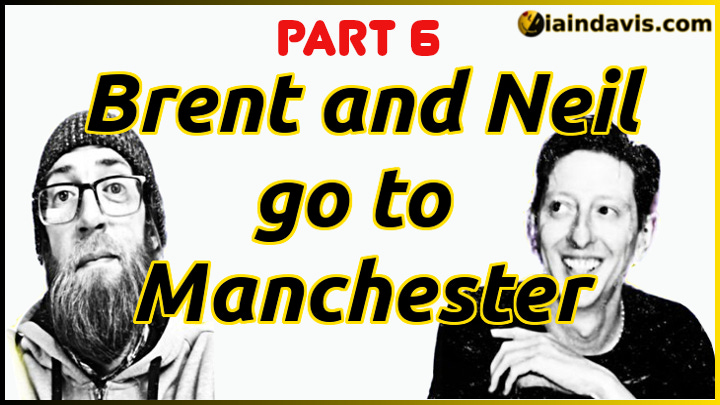


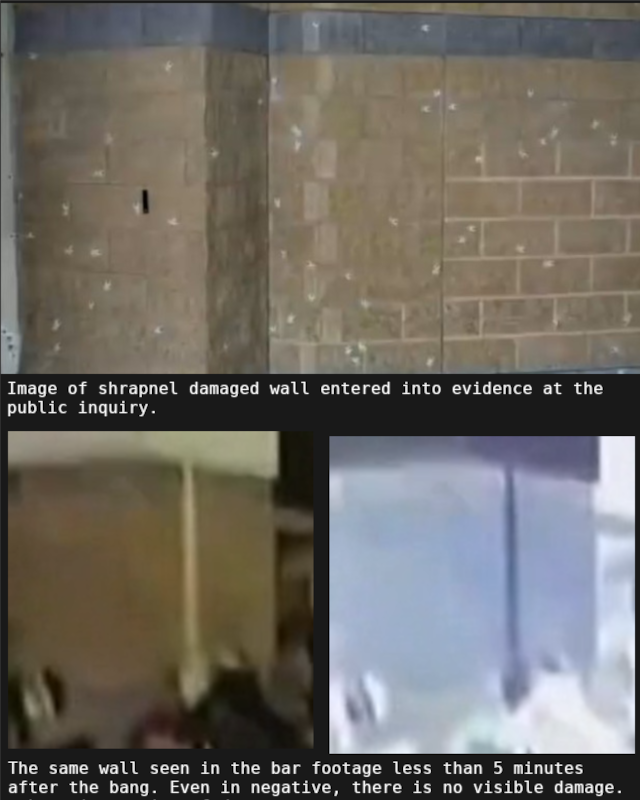
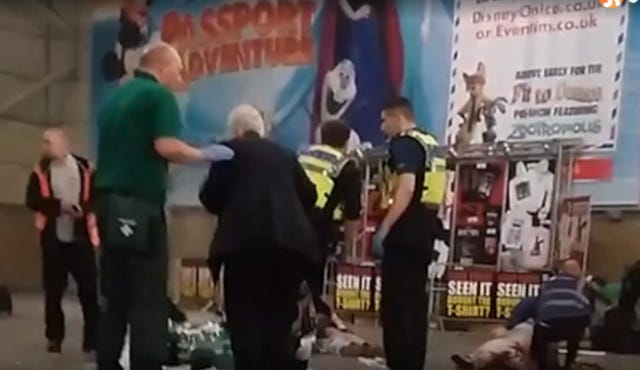

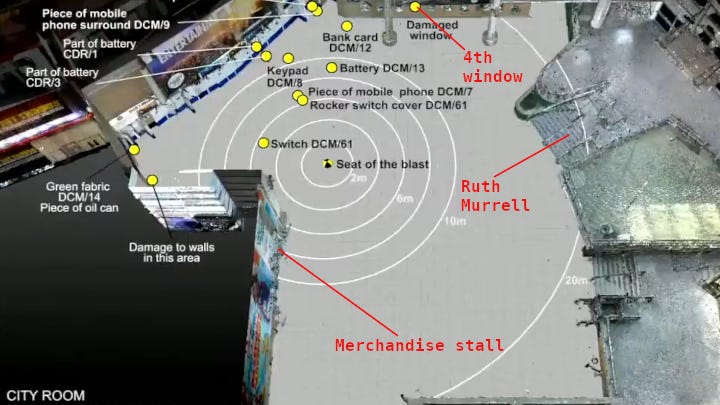
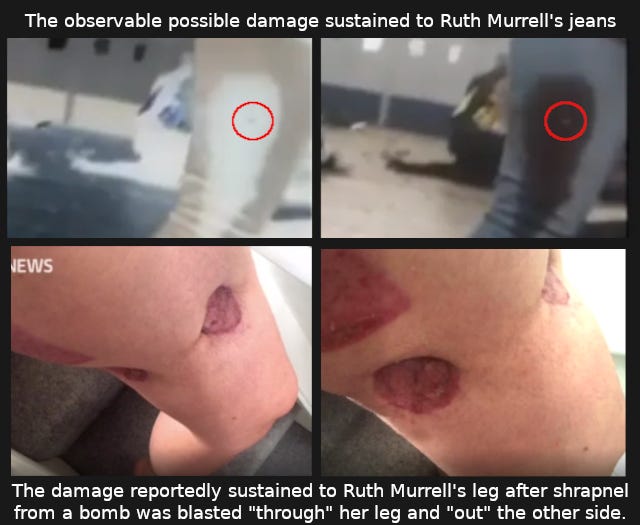

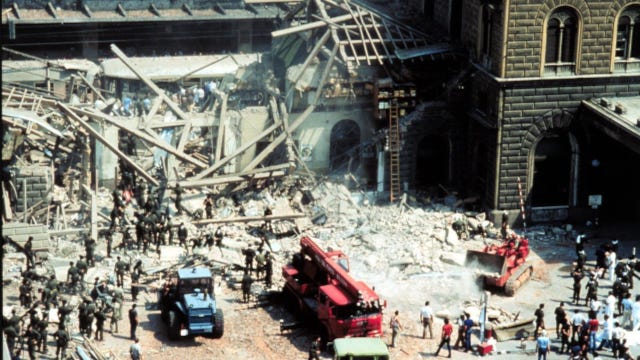
I'm surprised you're sceptical of what statement analysis can reveal, Iain.
Do you not agree that Peter Hyatt's examination of Kate and Gerry McCann's key interviews show a remarkable level of insight and understanding?
Many of the statements made by several of the alleged Manchester bomb victims, on the occasion of the Queen's visit to the hospital where they were being treated, contain a number of glaring inconsistencies that in no way tally up with the kinds of injuries supposedly inflicted. I think Richard Hall was right to subject these statements to the level of scrutiny outlined in his book.
Statement analysis, when conducted rigourously, is a crucial tool for helping us see what we might otherwise too readily gloss over. Peter Hyatt has certainly taught me to listen very attentively to the exact words people use. It's quite an eye opener to learn just how blatantly people betray their true feelings, through even the most innocuous sounding utterances.
They'd have never tried this shit on at a Pink Floyd or Talking Heads Concert, for very obvious reasons. Ariana Grande, FFS. She could easily be confused with an overpriced drink.